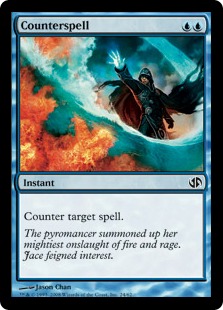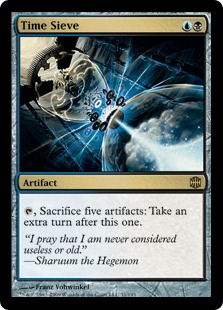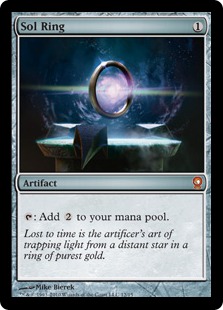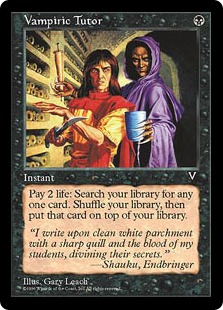Howdy, gang! I hope everyone had a suitably Magic-filled Christmas, and is ready to get back to some real brewing. Last article, I talked about my own Azusa Commander deck, and this week, I'd like to continue on from that to show you the steps to creating your own Commander deck, by not only leading you through the thought processes, but give you examples along the way.
1, Selecting your Colours and Commander

Now, to start off deck building, it's imperative to know what you wish to accomplish: Do you want to smother the battlefield with powerful board spells, or intricately build up a machine-like combo? Once you know what you need to accomplish, you can choose your colours accordingly. For the intricately minded, Blue offers a lot of tricks and disruption effects, while the aggressive strategies offered by both Red and Green may appeal to others among you.
You may not even want to choose your colours first: I have known many people (Including myself) to pick a Commander first and go with the colour(s) he or she offers. It's also fine if you like a Commander for his abilities, or even just sentimentality. It's Casual, so it's perfectly fine to have sentimentality enter the fray.
2, Knowing your Commander and your Plan of Attack
So, you've chosen your colours and (Hopefully) Your Commander. Now, we can start to build up an idea of the type of deck we would like to run. To do this, I often make a Pros and Cons list of what my deck should be able to do, as a result of my Commander choice. Doing this allows you to pinpoint both the strengths and weaknesses of your chosen Commander, and allows you to formulate basic plans of attack in order to fight your weaknesses. For example, if you need to sacrifice a creature in order to activate your Commander's effect, then having a few token generators allows you to use very little mana and card advantage to gain a continuous source of fodder.
Of course, knowing your Commander also means knowing your plan of attack, stemming into the Three major Archetypes: Control; Aggro; and Combo.
 Control decks tend to favour a permission style of play: That is, they allow you to control what happens on the board, either through 'Sweepers' (Effects that destroy all of a given type of card on the field, i.e. Day of Judgment), Counterspells (Mana Leak), and bouncing permanents to their controller's hand (Unsummon). Supplemented with a fair amount of card draw, this style of play always needs a fairly large card count in hand in order to benefit fully, and cards that recycle themselves, such as Capsize, are often at use in these forms of decks due to the lack of Card Advantage spent in order to gain their full effects.
Control decks tend to favour a permission style of play: That is, they allow you to control what happens on the board, either through 'Sweepers' (Effects that destroy all of a given type of card on the field, i.e. Day of Judgment), Counterspells (Mana Leak), and bouncing permanents to their controller's hand (Unsummon). Supplemented with a fair amount of card draw, this style of play always needs a fairly large card count in hand in order to benefit fully, and cards that recycle themselves, such as Capsize, are often at use in these forms of decks due to the lack of Card Advantage spent in order to gain their full effects.Aggro decks are the complete opposite of their Control counterparts: They want to win, and they want to do it as quickly and brutally as possible, either by playing a threatening creature every turn, or using fast ramp spells (Spells that increase your mana production or land count on the Battlefield) in order to put out their bigger Creatures as fast as possible. These strategies always include lots of efficient creatures that either have a high Power and Toughness, or that have very useful effects when in combat, such as Trample or Flying. Aggro decks also tend to have a lot of removal, either in the form of single-one-shot effects or their own versions of sweepers, and also gain benefit from having utility-style effects such as Hull Breach in order to target multiple threats at once.
 Combo decks are a little more complex than the previous Archetypes: Combo decks support combination play, in that they want to assemble a game-winning set of cards as fast as possible. Not usually running many creatures, these types of decks instead want to use Card Draw and Tutors (Cards that allow you to search your library for a specific type of card) in order to assemble said combo as quickly as possible. There are plenty of Combination plays available, and even Aggro and Control decks can use certain combos in order to gain advantage. Combo play is also the most versatile form of attack, which can result in milling the Opponent's library; dealing infinite damage to every player; and making infinite mana to support said combos. Combo decks are also, by their nature, very fragile: If one of your pieces is gone, you may have trouble reforming it, so it does take careful consideration in order to make the right plays.
Combo decks are a little more complex than the previous Archetypes: Combo decks support combination play, in that they want to assemble a game-winning set of cards as fast as possible. Not usually running many creatures, these types of decks instead want to use Card Draw and Tutors (Cards that allow you to search your library for a specific type of card) in order to assemble said combo as quickly as possible. There are plenty of Combination plays available, and even Aggro and Control decks can use certain combos in order to gain advantage. Combo play is also the most versatile form of attack, which can result in milling the Opponent's library; dealing infinite damage to every player; and making infinite mana to support said combos. Combo decks are also, by their nature, very fragile: If one of your pieces is gone, you may have trouble reforming it, so it does take careful consideration in order to make the right plays.3, Choosing cards to fit your plan
Now, most Pro Players will say that a good basis to any deck is knowing what your deck does, and how its cards interact. In Commander, there is very little difference: In fact, the nature of Highlander formats allows us to have more interactions between our spells, and generally the more our cards interact, the better our results become. Certainly, it is important to consider what cards you need to achieve certain goals, and how versatile these cards are in our overall plan. Not only that, we need a structure so that we don't overdo it on certain areas: We don't want to be drawing too many removal spells when we need a Creature to end the game for us.
As a basic plan, I tend to not have a fixed outline for deck building, as some decks need cards that others don't. As a basic principle, I would look to this as an outline;
-35-40 Land
As with any format, you can't do much without Land. This should be a mix of both colour-producing lands and utility lands. In accordance with the number of spells of a specific colour, your lands should have a similar ratio in producing those colours. Of course, two and three-colour decks have the benefit of Dual Lands and Tri-Lands in order to help fix their mana base. Utility lands are lands that serve a purpose other than producing mana, and should be at their minimum in a 3 or more colour deck. This will give you the right mana to cast your spells, but can be added to or reduced depending on the lands you need to accomplish your goals. Some lands can add Coloured mana as well as an effect, such as Oran-Rief the Vastwood, allowing you access to the lands without crippling your mana base.
-5-10 Mana producers (Land Search, Ramp, Artifact Mana)

Depending on the colour, you may have more or less access to Ramp. Green tends to be the best colour for land searching and ramping, and can easily be a support colour in a three colour deck to ensure you get your mana as fast as possible. However, in other colours this ramp is a little harder to achieve. One way around this is to use the best slots available within your colour: All colours have some form of Land search or ramp spells;
White: Land Tax; Weathered Wayfarer
Blue: High Tide
Black: Dark Ritual
Red: Desperate Ritual; Seething Song
It's up to you to weed out what you think is the best style of card for your deck. The second option is the use of Artifact-based mana. Though sometimes expensive in terms of monetary value, this allows you to ramp if your colour is a little weak in terms of options in this field. Cards such as Mana Vault, Darksteel Ingot, and the Signets from Ravnica Block offer fairly inexpensive ways of producing mana, and depending on your budget, Sol Ring makes an invaluable ally in Ramping for any deck.
-20-25 Creatures
Now, let me get this point across very clearly: Everyone has creatures in Commander. If you go in unprepared, you'll find it incredibly hard to win. These creatures can change, depending on the makeup of your deck, however. If you have a control style of deck, you may find that loading up on Removal is a better prospect than having more guys, and finding one to protect may be an easier prospect than having your creatures constantly destroyed.
I like to think of creatures in a few ways: I want a few creatures that do specific roles - Some to help me ramp, some to give me some utility, and some to win me the game. Getting the right balance is all about playing with the cards and finding out what works for you, and whether cards are optimal for the deck as a whole.
-7-12 Card Draw / Card Advantage
Having some form of card draw, even in colours that are scarce of it, allows you to keep refilling your hand and finding gas. Just like ramp, all colours have some form of draw, although some draw is better than others... and just like ramp, there are colourless options as well, though they tend to be more of a 'group hug' (Cards that help all players equally) field than anything. Colourless draw that is targeted (Jayemdae Tome, etc), can be expensive in most cases, but may be better than having no options at all.
-2-5 Tutors

Invaluable for combo decks, these allow you to find what you need straight away. Black tends to have the most versatile tutors, but some will cost you life. Depending on your game plan, you will need some form of tutoring in order to find what you need easier: If you know a card is key to your strategy, then packing a couple of ways to search it up is never a bad idea. These cards can be a little expensive in monetary terms depending on your colours, though, but there are always options in a field of 11,000 Cards. Reusable Tutors are always handy (Artificer's Intuition; Survival of the Fittest), and can let you go for whatever you need as you go through the game, often for minimal cost.
-8-10 Removal (Including Sweepers and Spot Removal)
As with creatures, removal is essential for any deck. The types of removal vary greatly from colour to colour: White prefers to destroy everything on the board or Exile certain threats, while Red prefers to burn everything to a crisp. The best way to pack your removal is to know that you have something for everything, so at least you have a chance at neutering opposing threats. The best cards in this category for versatility are the Command Cycle from Lorwyn Block. Each Command offers at least some form of removal over its four 'Modes', but that versatility means that the cards can still be useful should you not be under direct threat of a Woodfall Primus stomping on your face.
-10-15 Utility Spells (Recursion, Token Generators, etc)
These incorporate cards that aren't defined the above structure. These cards can include recursion, either returning cards to play or to your hand, or cards that allow you added utility in some regard. These cards are usually tied to your Commander in some way, either in creating a combination play, or just in aiding your board position a little by letting you re-use key cards.
Now, the structure is never a perfect structure: You can never tie many strategies into one style of deckbuilding, but you can at least get a starting point from this style of thinking. Just think of what you need to be playing, and dedicate an area of your 100 cards to that specific point.
4. Testing and tweaking your Deck.
Of course, Commander is meant to be a fun format, but that doesn't mean you can't always tweak your deck. Building the deck is half of the fun, but actually playing and enjoying your deck is the major part of any game of Magic. Now, you can never make a perfect Commander deck on the first try: I find myself always finding cards that I want to try, or cards that I didn't find were up to the task that I'd set for them.
Deck Construction in this format should be in a constant state of flux: You should always want to try and adapt your strategies, try new cards if and when your budget allows, or even so much as change the Commander you're using if it means developing your play style further. If there's one thing I want you to take away from this, it is that you never have to keep your deck the same: Change cards, mix it up a little, and you'll find your understanding deepen, and even take some helpful hints into Standard or Drafting at the next WNM. Your deck won't evolve if you don't evolve with it.
5. Repeat Ad Nauseam
Now, once you've caught the bug of actually building and playing decks, you can experiment with new colours and Commanders. The world of Commander is a constantly evolving format: With each new set comes new potential for Commanders, new removal cards, and new cards to supplement our strategies. Only by exploring these intricacies will we find our new ways to play.
...and with that, I will bid thee adieu. I hope you enjoyed this week's segment as much as I enjoyed writing it. Until next week, feel free to use the links below to contact me, or just grab me for a chat at WNM next week.
Until then, take your game to the next level!
Andy P
e-mail: Ajpem@castlecore.com
MSN: Mirage_Knight@hotmail.co.uk
Excellent article! I'm planning to build budget commander decks and gift one to a friend, as he has limited funds, so very useful Andy ;-)
ReplyDeleteDan H
I built a commander deck now (with proxies) and it was loads of fun :D. Thanks for the recommended deck structure, it made it a lot easier than just chucking 100 cards I like against a wall and seeing what stuck ;)
ReplyDelete